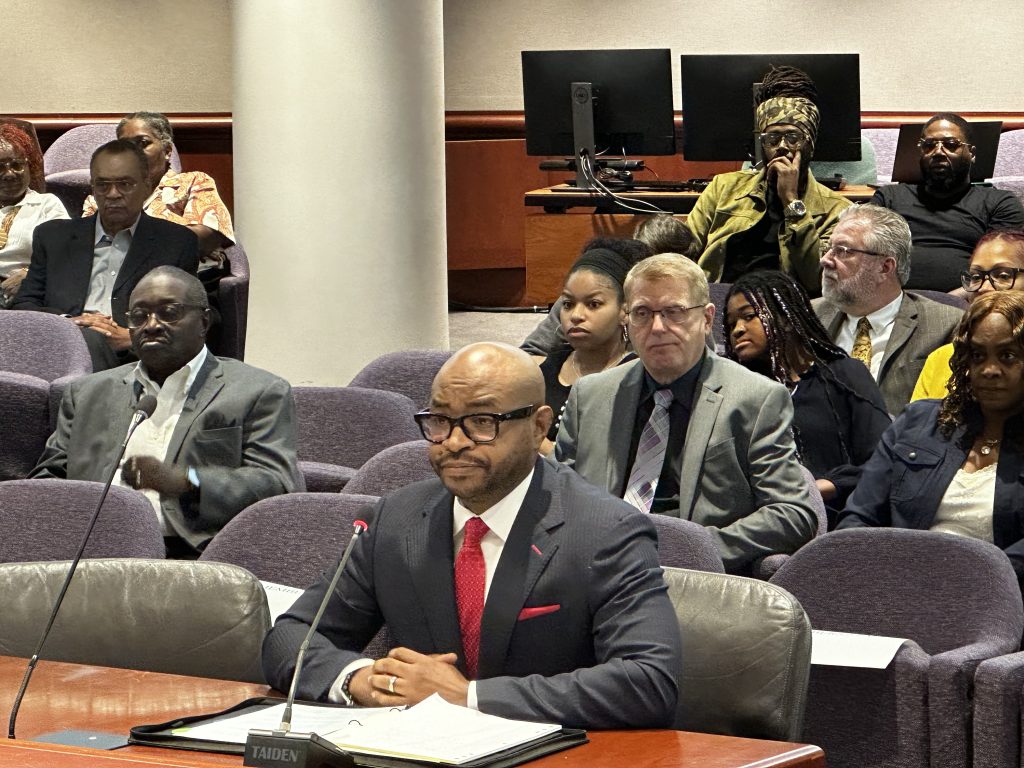Connecticut lawmakers approved the nomination of Raheem Mullins, Gov. Ned Lamont’s choice to serve as the next Supreme Court Chief Justice, after nearly two hours of questioning about his background, several of his prior legal opinions and his ambitious plans for how to improve the state’s judicial branch.
The members of the Legislature’s Judiciary Committee overwhelmingly supported Mullins’ nomination, which will allow him to serve in an interim capacity as chief justice until the full legislature can take up his appointment early next year.
Several lawmakers took the opportunity on Monday to credit Mullins’ background and his depth of experience in Connecticut’s judiciary.
They noted that Mullins, who is the second Black chief justice in the state’s history and one of the youngest people to be appointed as an associate justice of the Supreme Court, has served as a judge in every level of the state’s court system.
While there were several questions from Republicans about Mullins’ “judicial philosophy” and his previous decisions on the Supreme Court, the public hearing clearly highlighted the widespread support for his appointment among state lawmakers.
“I heard from folks — Republicans, Democrats, people out there on the criminal side, the civil side — and everybody has sung your praises,” Sen. John Kissell, ranking Republican on the Judiciary Committee, told Mullins at the beginning of the hearing. “They just think that you are inherently fair and balanced and not easily pigeonholed, conservative or liberal.”
[RELATED: A CT chief justice bids farewell, and another’s confirmation to begin]
Only Sen. Rob Sampson, R-Wolcott, voted against Mullins’ appointment following the hearing.
The fact that Mullins has served on the Supreme Court as an associate justice since 2017 and has gone before lawmakers for confirmation hearings on multiple occasions allowed lawmakers to focus less on Mullins’ qualifications and “temperament” and more on his plans as the upcoming leader of the state judicial branch.
Mullins used a significant portion of his opening statement to discuss his plans for how to improve the administration and technology of the state’s courts.
Lawmakers responded positively to Mullins’ recommendations to significantly upgrade Connecticut’s courthouses and website in order to bring the judicial branch “fully into the 21st century.”
“I realize I’ve spent a good amount of time focusing on technology, and I am a true believer regarding its potential,” Mullins told lawmakers.
“My vision for the judicial branch is this: To leverage technology so that we can enhance access, efficiency and transparency, with the ultimate goal being to better serve our citizens,” he added.
The list of technological updates that Mullins rattled off was not short.
He called for traffic and small claims cases to be managed via remote hearings. He discussed the need for additional technology to help court interpreters remotely participate in hearings and trials in courthouses throughout the state. And he said it was time for Connecticut to finally start compiling records from the state’s juvenile and criminal courts in a digital format.
Unlike the state’s civil court system, he said, every motion and filing in the criminal courts is still maintained on printed paper.
Rep. Steven Stafstrom, the Democratic co-chair of the judicial committee, agreed with Mullins about the need for a digital overhaul in Connecticut’s criminal courts.
Stafstrom, an attorney who represents Bridgeport, said that in federal court, a lawyer can present their entire case on their laptop. But Connecticut’s criminal courts, he said, are still being run like they were in the 18th century.
Mullins said the digitization of criminal court records is one of his top priorities, but he said the larger goal is to create “state of the art digital courtrooms” throughout Connecticut. Mullins envisioned a system where attorneys and members of the public would be able to access court records from their phones and jurors would each have a tablet or iPad to review evidence during trials.
But if the judicial branch is going to be successful in that modernization effort, Mullins said the state will need to make significant — and potentially costly — upgrades to its physical infrastructure.
Mullins noted that most courthouses in Connecticut don’t even have wireless internet capabilities.
“In this technology driven world of ours, it is unacceptable to me that the Torrington is the only courthouse in the state of Connecticut that has Wi-Fi,” Mullins said.
“The lack of Wi-Fi is a recurring complaint from the public and is the exact type of experience that negatively impacts the public’s perception of the court,” he added.
Any discussion about the judicial branch’s technology, Mullin said, is also likely to be complicated by the age and condition of of some of the state’s courthouses and other judicial facilities.
Mullins acknowledged that courthouses may need to be renovated or completely replaced. And he noted that such investments would likely require action from state lawmakers, who control the state’s budget.
“It’s important that I make clear that I look forward to working with the legislature to achieve many of these goals,” Mullins said.

